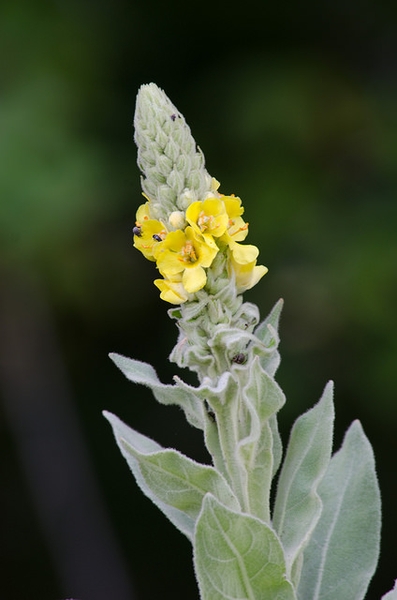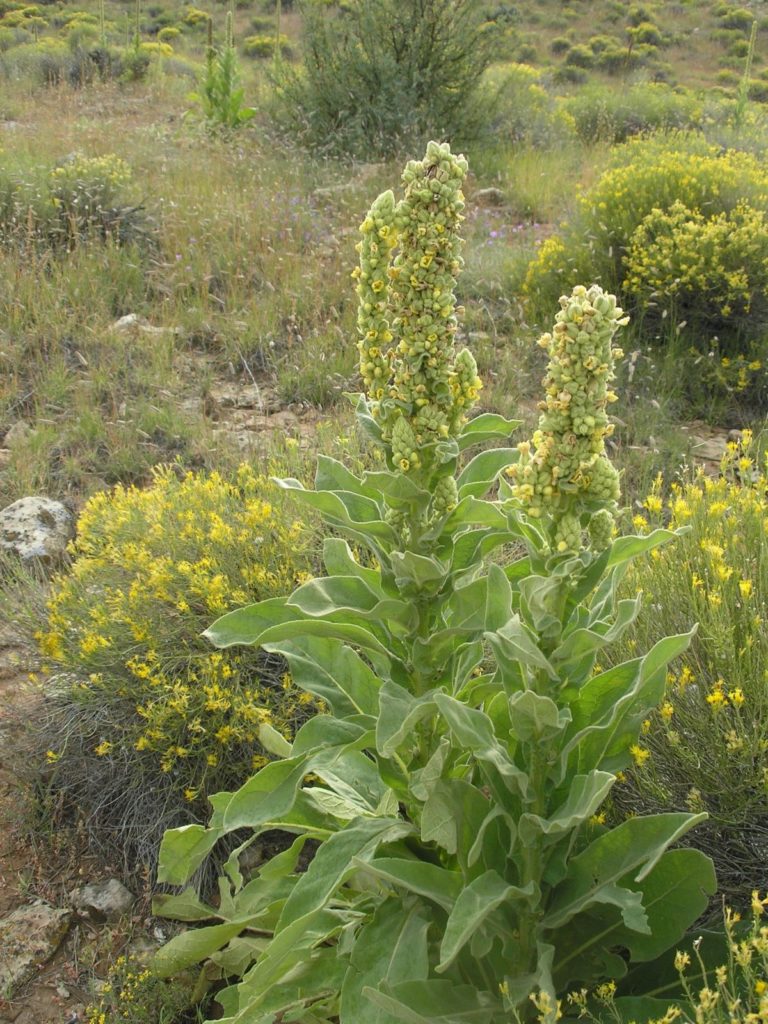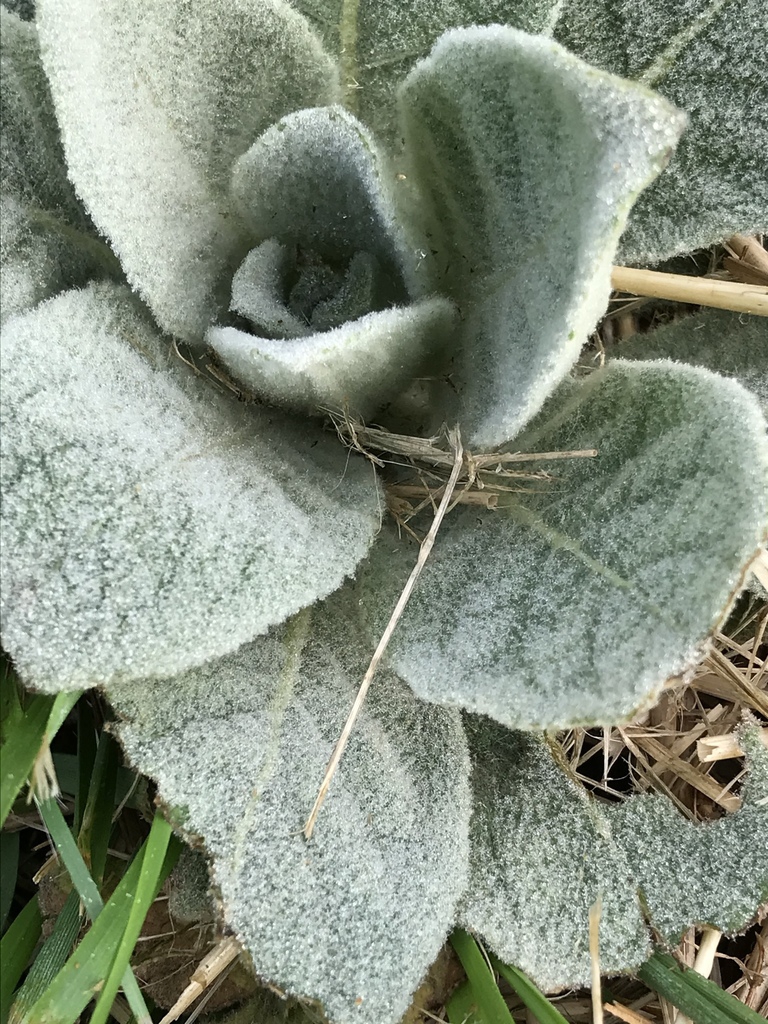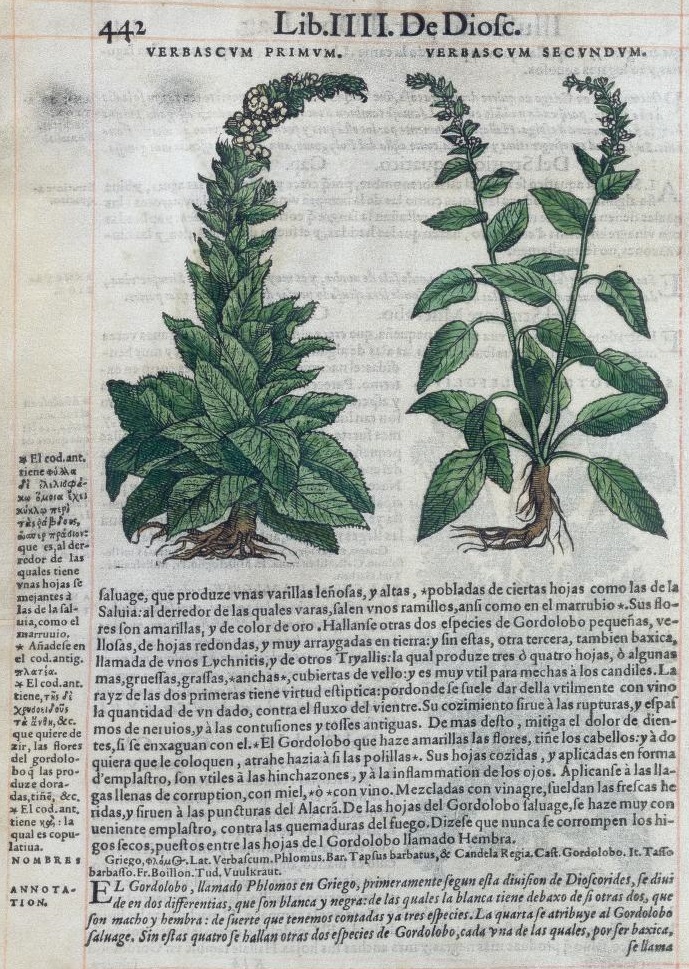Scientific name: Verbascum thapsus L.
Common name: mullein, common mullein, wooly mullein, barbasco
Family: Scrophulariaceae (Figwort)

Verbascum thapsus flowers. Photo credit: Suzanne Cadwell
CC BY-NC 4.0. N.C. Cooperative Extension.
Native distribution: Eurasia, North Africa
Habitat: Disturbed areas, plains, hillsides, fields, roadsides
Height: 2-7 feet
Hardiness: USDA zone 3
Life form: Biennial / short-lived perennial
Occurrence in New Mexico: Exotic
Article by Eva Maria Räpple
“No plants of the whole summer through are more picturesque than the Mulleins… In the garden they are best at the back of the borders, but in waste places they may stand boldly in the open to shine against the sky. Their flowering season lasts fully two months and in partial shade the individual blossoms last long in perfection.” (Louise Beebe Wilder, early 20th century author) [1]
Verbascum thapsus is native to Europe, northern Africa, and Asia from Siberia south to the Himalayas. It has naturalized in the United States and other parts of the world and is found throughout the Santa Fe region, where it is a delightful sight in meadows, desert shrublands, forest clearings, burn scars or roadsides.
During its first year, mullein is a low growing rosette with fuzzy, silvery leaves that remain semi-evergreen during the winter. Cold temperatures (vernalization) are required for the plant to flower; the flower stalks typically appear in the second year and may be singular or branching. Each plant opens only a few of its five-petaled flowers at a time, opening before dawn and closing in the afternoon, attracting a wide variety of bees, butterflies and insects.[2] The tall flowering stems and attractive rosettes of the common mullein can add beautiful color and texture to gardens.
Thick taproots allow this very hardy plant to grow on dry, compacted soil. It requires sunny spots, and likes bare gravel of chalky soils although it can tolerate other soils. Its dead leaves add nutrients to the soil, helping other plants to thrive. Despite its prolific seed production, it rarely becomes invasive because it requires special conditions such as open ground and sunshine to germinate.[3] Mullein varieties include not only the widespread common mullein with its yellow flowering stalks but feature, among others, the stunningly beautiful Verbascum phoeniceum (purple mullein) with flowers in tones of violet, lilac, white and rose. This species, though, does not grow as tall as the common mullein.[4]

Verbascum thapsus by Kirstin Olmon. SEINet Portal Network. 2023. (CC BY-SA)
The name Verbascum is derived from the Latin barbascum or bearded, describing the hairy stamens of this genus. The common name “mullein” also comes from a Latin base, mollis, referring to the soft hairs that cover the leaves.

Verbascum thapsus leaf closeup. Credit: K. Andre, CC BY 2.0.
Watch out, these little hairs can sometimes cause irritation on bare skin. Verbascum has many medicinal qualities, described as far back as the 1st century CE by the Greek physician Pedanius Discorides. The doctor recommended the plant particularly for conditions of the lung in his “De Materia Medica”, a five-volume work (50-70 CE) which was copied and consulted over 1500 years until it was revised during the Renaissance.[5]

“De Materia Medica” by Dioscorides
Mullein’s outstanding health benefits have been utilized by many herbal traditions, which were brought to North America by European colonists and integrated into Native American healing traditions. The Abanaki tribe used the roots to make a necklace for teething infants, and Native American people have used the leaves as a poultice for wound care, swollen glands, rashes, and infections. Mullein can be used as an extract, made into syrup or tea.[6] It has been used for centuries as an expectorant, offering throat and lung relief for colds, coughs, and asthma. Tea made from mullein leaves supports the body in fighting viral infections and the leaves and flowers carry anti-bacterial properties and are soothing and calming to nerves, contributing to a good night’s rest.[7] Mullein flower oil combined with garlic has been a favorite in fighting earaches.[8] Recent studies have also shown antidiabetic properties and attracted the attention of researchers as a strong source of anti-oxidant effects in the human body.[9]
Beyond medical applications, soaking mullein flowers and shredded leaves for one to two days provides excellent yellow dyes for yarn.[10] Mullein stalks dipped in wax can be used as torches. The stately, tall plant is also called “Königskerze” (King’s Candle). Without question, it captivates attention and offers a stunning sight.
[1] Wilder, Louise Beebe. Color In My Garden. Garden City, New York: Doubleday Page & Company, 1918. 157. https://www.biodiversitylibrary.org/page/29055963#page/179/mode/1up (accessed October 3, 2023)
[2] Wisconsin Horticulture. “Common Mullein. Verbascum Thapsus”. University of Wisconsin-Madison. https://hort.extension.wisc.edu/articles/common-mullein-verbascum-thapsus/ (accessed October 16, 2023)
[3] North Carolina Extension Gardener Plant Toolbox. “Woolly Mullein, Verbascum Thapsus.” https://plants.ces.ncsu.edu/plants/verbascum-thapsus/ (accessed October 7, 2023)
[4] Wilder, Louise Beebe. Color In My Garden.
[5] Discorides, Pedanius. De Materia Medica. Library of Congress. https://www.loc.gov/item/2021666851/ (accessed October 7, 2003)
[6] Mountain Rose Herbs. “Mullein Leaf.” Eugene, Oregon. https://mountainroseherbs.com/search-results-page?q=mullein (accessed October 14, 2023)
[7] Saman Mahdavi et al. “The Antioxidant, Anticarcinogenic and Antimicrobial Properties of Verbascum thapsus L” L. Med Chem. 2020; 16 (7): 991-995 https://pubmed.ncbi.nlm.nih.gov/31456524/ (accessed October 9, 2023
[8] Pursell, J.J. The Herbal Apotecary. Portland, Oregon: Timber Press, 2015. 234.
[9] Hatice, KiziltaV et.el. “Analysis of Phenolic Compounds by LC-HRMS and Determination of Antioxidant and Enzyme Inhibitory Properties of Verbascum speciosum Schrad” Records of Natural Products 2023; !7 (3) 485-500.
[10] Sherra V. “Mullein”. The Lost Herbs. https://thelostherbs.com/mullein/ (accessed October 15, 2023)


